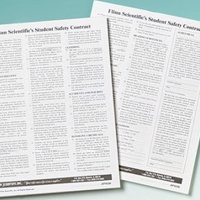Safety First is No Accident
By Mike Marvel, PhD Chemist and Team Leader
Safety First describes the vision and goals that all science instructors, lab managers and administrators share for science labs. We all say that safety always comes first. But what does this mean in practice? The following policies and procedures will help you transform this slogan from a vision into a reality and ensure safety in science labs.
The Culture of Safety
Safety First is above all an attitude or culture that must be established and nurtured. The culture of science or lab safety is a shared responsibility that depends on all individuals working together to protect themselves, each other, the students, and indeed the community. The administration, faculty and staff, the students and the community all benefit from the success of the Safety First philosophy. The process of ensuring lab safety requires that all individuals recognize their unique roles and carry out their assigned functions. While the main goal of a Safety First culture is to prevent or reduce accidents and injuries, the long-term benefits may be even more important. Safety First will be the students’ vision of science throughout their lives!
General Safety Responsibilities
The administrators, faculty and staff must provide leadership and policies to establish a culture of safety. They all share the responsibility for maintaining a safe lab environment. The administrators have to establish and enforce a safe working environment. Lab managers have to purchase and provide all required personal protective equipment (PPE) and other necessary safety supplies. Science instructors are responsible for what takes place during a lab session. They supervise students in the classroom and lab, provide adequate instructions and warn students of the possible dangers involved in performing laboratory activities.
Most states and/or the federal government require colleges to have a written safety manual, called a Chemical Hygiene Plan, summarizing the policies and procedures for the use of laboratory chemicals. The safety manual should include general laboratory rules and procedures, safety and personal protective equipment requirements, spill and accident procedures, chemical storage rules and requirements, inspection procedures, employee safety training, processes for evaluating and monitoring chemical exposure, and emergency response.

